Yesterday was my day to volunteer at the Pima Air & Space Museum, where I lead back-to-back walking tours at 10:30 and 11:30 AM every Wednesday. There were no takers for the 10:30 tour, so I used my unexpected free hour to walk around the grounds taking photos of new exhibits.
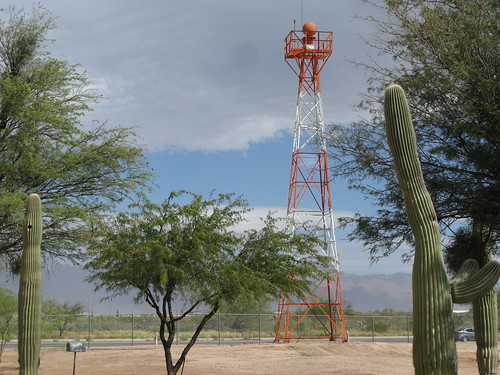
The first thing to catch my eye was an unassuming red and white tower that had just been put up near the museum entrance, an aerial navigation light beacon from the late 1920s. After Lindbergh’s New York to Paris flight in 1927, the public began to embrace the idea of air travel and a burgeoning American airline industry began regular day and night service between cities. In those days, airline and airmail pilots navigated by landmarks, compass headings, and clocks. At night, they used lights. Aerial navigation light beacons were used extensively between the late 1920s and the end of the 1930s, and were operated by the Airways Division of the US Lighthouse Service.
The public called them “Lindbergh beacons” or “Lindy lights,” of course (in those heady days, nearly everything associated with aviation was a Lindy this or a Lindbergh that). Normally, Lindy lights sent out a single rotating beam of white light. If the beacon wasn’t co-located with an airfield, as with the one mounted atop the Palmolive Building in Chicago, a second beam of light pointed toward the associated airfield, in that case the nearby Chicago Municipal Airport. The one at our museum, which was put up in 1929 at Douglas Airport, Arizona, emitted just the single rotating beam. At some point during the 1930s Lindy lights began to be replaced by directional radio beacons and pilots quit using them for night navigation. They live on today as aerodrome beacons, those rotating two-beam green and white lights you see at airports (a single green beam alternating with a single white beam for civilian airfields, a single green beam alternating with two white beams for military airfields).
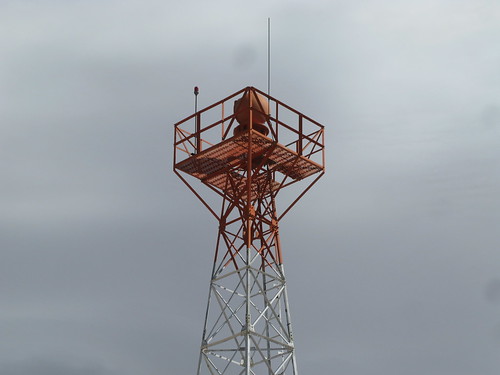
Earlier this year our museum-within-a-museum, the 390th Memorial Museum, closed its doors for a remodeling project. Last week it reopened and the public can once again see our beautiful B-17 Flying Fortress, along with exhibits of B-17 memorabilia from WWII. What’s really nice is that the renovated building has a mezzanine from which visitors can look down on the displays. When I photograph airplanes at the museum I’m always wishing I climb up on something in order to take photos from another angle; here at least I can finally do that.
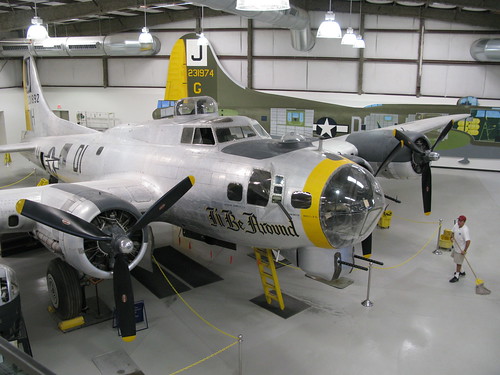
Finally, our lake-bottom Wildcat is back on display, after what to me is an inexplicable partial restoration. Here’s what it used to look like:

Grumman designed and built the F4F Wildcat, but after the factory switched wartime production to F6F Hellcats, General Motors’ Eastern Aircraft Division picked up Wildcat production (GM-built Wildcats were designated FM-2s to distinguish them from Grumman-built F4Fs). This particular Wildcat was assigned to the US Navy’s Carrier Qualification Training Unit at Glenview, Illinois, and was ditched in Lake Michigan some time around 1945. Per PASM’s website: “Two Great Lakes paddlewheel steamers were converted into aircraft carriers. The USS Wolverine and USS Sable sailed from Chicago’s Navy Pier each day to let new aviators practice landing and taking off from ships. The combination of new pilots and the inherently dangerous activity of landing on a moving ship resulted in many aircraft littered across the bottom of southern Lake Michigan. Fortunately for future historians Lake Michigan has just the right combination of depth, cold and fresh water to preserve these aircraft.”
I loved our old submarine Wildcat just as it was. But the museum has partially restored it, and I’m not sure why. Anyway, here’s what it looks like now:
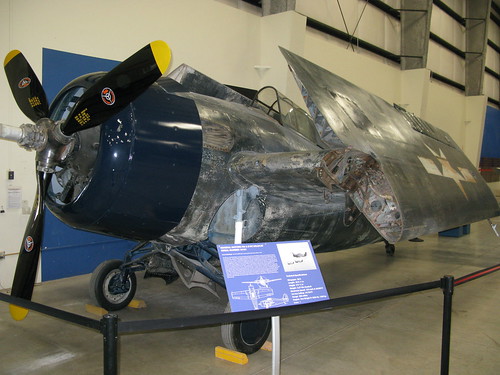
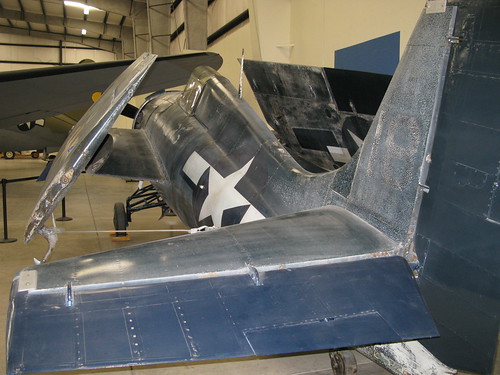
Maybe the idea is to show visitors what a restoration in progress looks like, and if so I can get behind that. We need some unrestored aircraft on display here and there, if only to show visitors what a monumental job it is to bring a derelict wreck back to life. But the Wildcat, as it used to be, fulfilled that purpose anyway, and I’m sorry they felt they had to “improve” it.